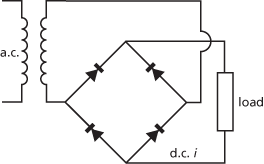An electrical device that allows more current to flow in one direction than the other, thus enabling alternating e.m.f.s to drive only direct current. The device most commonly used for rectification is the semiconductor diode. In half-wave rectification, achieved with one diode, a pulsating current is produced. In full-wave rectification two diodes are used, one pair conducting during the first half cycle and the other conducting during the second half. The full-wave rectified signal can be smoothed using a capacitor or an inductor. The bridge rectifier illustrated also gives full-wave rectification.

Bridge. Bridge rectifier.
A device that passes current only in the forward direction and can therefore be used as an a.c. to d.c. converter. A single device usually suppresses or attenuates alternate half-cycles of the alternating-current input (see half-wave rectifier circuit). Full-wave rectifiers usually contain two devices in a back-to-back arrangement. The most common type of rectifier is the semiconductor diode. The rectification efficiency of any rectifier is the ratio of the direct-current output power to the alternating-current input power.
The output of a rectifier consists of a unidirectional current that rises to a maximum value periodically; this value corresponds to the peak value of the alternating-current input. The output is usually smoothed by a smoothing circuit before being applied to the load in order to reduce the amount of ripple. The fluctuating output can be considered as a steady d.c. component with an a.c. component superimposed on it. A portion of the ripple is sometimes due to the rectifier leakage current, i.e. alternating current that flows through the rectifier without being rectified.
- substitute natural gas
- substitution
- substitutional quantification
- substitution cipher
- substitution effect
- substitution group
- substitution((in genetics))
- substitution reaction
- substitutivity salva veritate
- substorm
- job scheduling
- job search
- jobseeker’s allowance
- Jobs, Steve (1955–2011)
- job step
- job stream
- job vacancy
- Job’s Coffin
- jock
- Jodl, Alfred (1890–1946)
- Jodrell Bank Observatory
- Joffre, Joseph Jacques Césaire (1852–1931)
- Johannian
- Johannsen, Wilhelm Ludwig
- Johansen’s approach